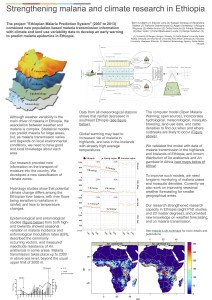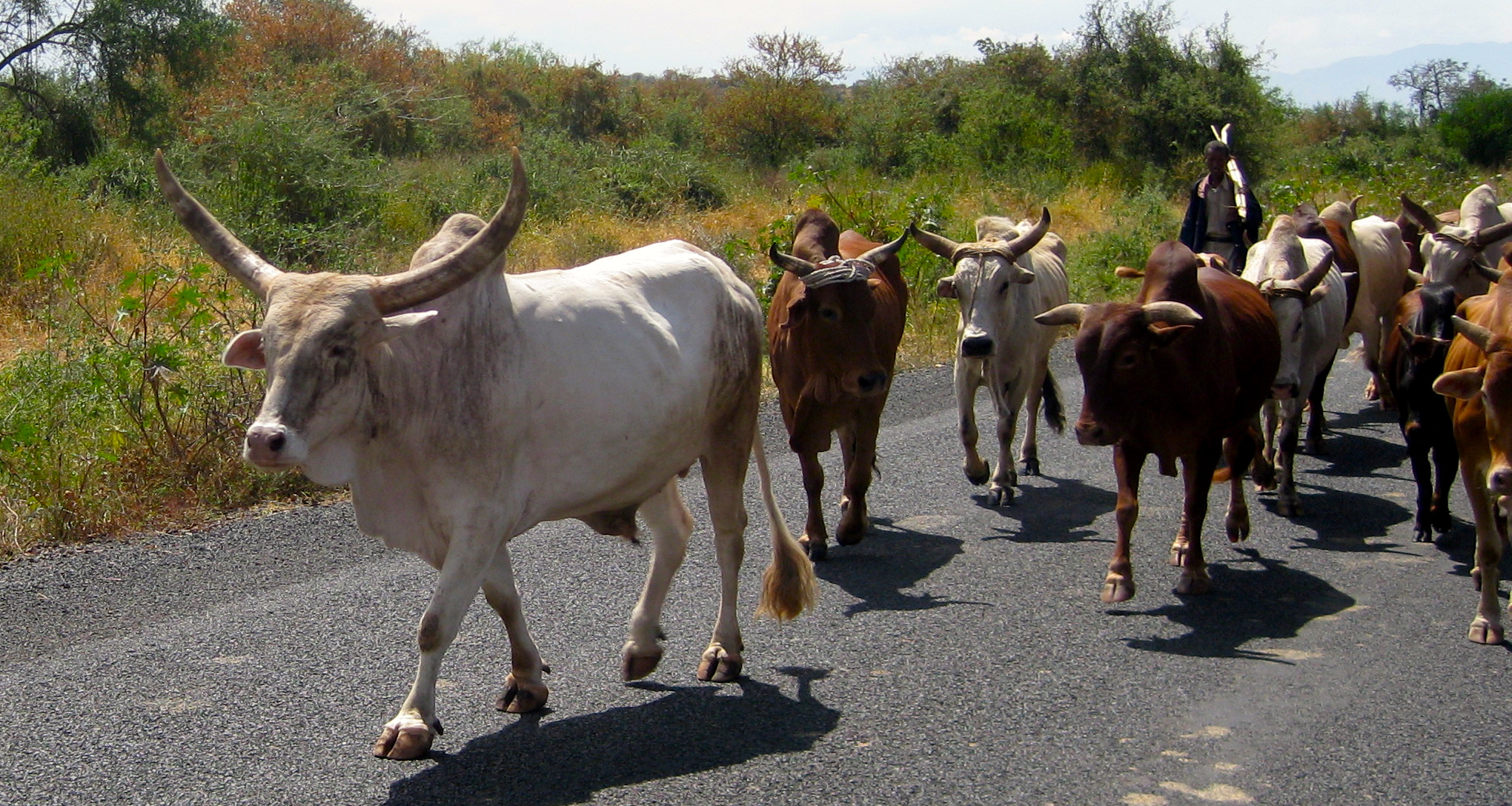I have recently updated our malaria research web site; please see http://malaria.w.uib.no
Category Archives: EMAPS
Strengthening malaria and climate research in Ethiopia
 Lindtjorn B, Loha E, Deressa W, Balkew M, Gebremichael T, Sorteberg A, Woyessa A, Animut A, Diriba K, Massebo F, et al: Strengthening malaria and climate research in Ethiopia. Malaria Journal 2014, 13:P56.
Lindtjorn B, Loha E, Deressa W, Balkew M, Gebremichael T, Sorteberg A, Woyessa A, Animut A, Diriba K, Massebo F, et al: Strengthening malaria and climate research in Ethiopia. Malaria Journal 2014, 13:P56.
Poster presentation
The project “Ethiopian Malaria Prediction System” implemented from 2007 to 2012 combined new population-based malaria transmission information with climate and land use variability data to develop an early warning tool to predict malaria epidemics in Ethiopia. Scientists from Ethiopia and Norway collaborated to incorporate climate variability and forecast information for malaria epidemics.
Our study shows that the association between weather and malaria is complex. Statistical models can predict malaria for large areas. However, as malaria transmission varies and depends on local environmental conditions, we need to have good and local knowledge about each area. However, weather variability is the main driver of malaria in Ethiopia.
While the generation of precipitation depends on local ascent and cooling of the air, our research provided new data on the transport of moisture into the country that may improve weather forecasting. We developed a new classification of climate zones, have mapped drought episodes in Ethiopia during the last decades, and have improved seasonal weather forecasting. Our hydrology studies show that potential climate change differs among the Ethiopian river basins, with river flows being sensitive to variations in rainfall, and less to temperature changes.
The computer model, Open Malaria Warning, incorporates hydrological, meteorological, mosquito-breeding, land-use data, and cattle densities to find out when and where outbreaks are likely to occur. We validated the model with data for malaria transmission in the highlands and lowlands, characterizing malaria transmission over some years in both highlands and lowlands. This provided us with new knowledge on malaria transmission in Ethiopia, how intense the seasonal transmission is, and how malaria occurs in different populations and areas. Our study showed that indigenous malaria transmission during a non-epidemic year takes place above 2000 m altitude. We also showed the ideal temperature for malaria transmission is about 25°C, underlining that global warming may lead to increased risk of malaria in highland areas, and less in the lowlands with already high average temperatures. However, to validate such models, there is a need for several years of active monitoring of malaria cases and mosquito densities. Unfortunately, such data is rare in Africa, and we need to invest in long-term monitoring of malaria transmission.
Lindtjorn-Malaria conference poster
Ownership and use of long-lasting insecticidal nets for malaria prevention in Ethiopia
Woyessa A, Deressa W, Ali A, Lindtjorn B. Ownership and use of long-lasting insecticidal nets for malaria prevention in Butajira area, south-central Ethiopia: complex samples data analysis. BMC public health 2014; 14: 99.
BACKGROUND: Despite the encroaching of endemic malaria to highland-fringe areas above 2000 meters above sea level in Ethiopia, there is limited information on ownership and use of mosquito nets for malaria prevention. Thus, this study was designed to assess long-lasting insecticidal nets (LLIN) possession and use for malaria prevention in highland-fringe of south-central Ethiopia.
METHODS: A multi-stage sampling technique was employed to obtain household data from randomly selected households using household head interview in October and November 2008. Household LLIN possession and use was assessed using adjusted Odds Ratio obtained from complexsamples logistic regression analysis.
RESULTS: Only less than a quarter (23.1%) of 739 households interviewed owned LLINs with more differences between low (54.2%) high (3.5%) altitudes (Χ2 =253, P < 0.001). Higher LLIN ownership was observed in illiterate (adj.OR 35.1 [10.6-116.2]), male-headed (adj.OR 1.7 [1.051-2.89]), owning two or more beds (adj.OR 2.7 [1.6-4.6]), not doing draining/refilling of mosquito breeding sites (adj.OR 3.4 [2.1-5.5]) and absence of rivers or streams (adj.OR 6.4 [3.5-11.8]) of household variables. The presence of ≥2 LLINs hanging (adj.OR 21.0 [5.2-85.1]), owning two or more LLINs (adj.OR 4.8 [1.3-17.5]), not doing draining/refilling of mosquito breeding sites (adj.OR 4.2 [1.3-13.6]), low wealth status (adj.OR 3.55 [1.04-12.14]), and < 1 km distance from absence of rivers or streams (adj.OR 3.9 [1.2-12.1]) of households was associated with more likely use of LLIN. The LLIN ownership was low in the highlands, and most of the highland users bought the bed nets themselves.
CONCLUSIONS: This study found a low household LLIN ownership and use in the highland-fringe rural area. Therefore, improving the availability and teaching effective use of LLIN combined with removal of temporary mosquito breeding places should be prioritized in highland-fringe areas.
Screening houses prevents malaria
The results of this randomized trial show that screening doors and windows, and closing openings on walls and eves by mud reduced the overall indoor densities of An. arabiensis by 40%. Although screening intervention reduced indoor density of An. arabiensis at all abdominal stages, the reduction was substantially higher against unfed An. arabiensis. The intervention was based on locally bought materials, and was affordable.
Massebo F, Lindtjorn B. The effect of screening doors and windows on indoor density of Anopheles arabiensis in south-west Ethiopia: a randomized trial. Malar J 2013; 12(1): 319.
Torleif Markussen Lunde defended his PhD
Torleif Markussen Lunde defended his PhD thesis on Monday August 19, 2013.
The title of the thesis is: «On the dynamics of two efficient malaria vectors of the Afrotropical region: Anopheles gambiae s.s and Anopheles arabiensis».
For more information see our malaria research blog.
Two new malaria articles
Our malaria research group recently published two new articles about malaria in south Ethiopia:
Massebo F, Balkew M, Gebre-Michael T, Lindtjorn B. Entomologic Inoculation Rates of Anopheles arabiensis in Southwestern Ethiopia. Am J Trop Med Hyg 2013.
Woyessa A, Deressa W, Ali A, Lindtjørn B. Malaria risk factors in Butajira area, south-central Ethiopia: a multilevel analysis. Malaria Journal 2013, 12:273.
Adugna Woyessa defended his PhD
On May 30th, 2013, Adugna Woyessa defended his PhD thesis «The epidemiology of highland malaria in Ethiopia: a study from Butajira area».
Cattle (and mosquitoes) in Africa
 New research uses almost 50 years of data to investigate how climate has affected cattle holdings in Africa since 1961. Such research is important also to understand the distribution of mosquitoes that transmit malaria.
New research uses almost 50 years of data to investigate how climate has affected cattle holdings in Africa since 1961. Such research is important also to understand the distribution of mosquitoes that transmit malaria.
Lunde TM and Lindtjørn B. Cattle and climate in Africa: How climate variability has influenced national cattle holdings from 1961–2008. PeerJ 2013; 1:e55
The role of cattle in developing countries is as a source of high-quality food, as draft animals, and as a source of manure and fuel. Cattle represent important contribution to household incomes, and in drought prone areas they can act as an insurance against weather risk. So far, no studies have addressed how historical variations in temperature and rainfall have influenced cattle populations in Africa.
The focus of this study is to assess the historical impact of climate variability on national cattle holdings. We reconstruct the cattle density and distribution for two time periods; 1955–1960 and 2000–2005. Based on estimates from FAO and official numbers, we generated a time series of cattle densities from 1961–2008, and compared these data with precipitation and temperature anomalies for the same period.
We show that from 1961–2008 rainfall and temperature have been modulating, and occasionally controlling, the number of cattle in Africa.
Insecticide resistance in Southwest Ethiopia
The greater tendency of An. arabiensis to feed on cattle justifies the application of insecticides on cattle to provide a significant protection from malaria infection. But, An. arabiensis has already developed resistance to the available insecticides, and alternative insecticides are needed.
Massebo F, Balkew M, Gebre-Michael T and Lindtjørn B. Blood meal origins and insecticide susceptibility of Anopheles arabiensis from Chano in South-West Ethiopia. Parasites & Vectors 2013, 6:44 doi:10.1186/1756-3305-6-44
Background Anopheles arabiensis, the main malaria vector in Ethiopia, shows both anthropophilic and zoophilic behaviours. Insecticide resistance is increasing, and alternative methods of vector control are needed. The objectives of this study were to determine the blood meal origins and the susceptibility to insecticides of An. arabiensis from Chano village near Arba Minch in South-West Ethiopia.
Methods Blood meal sources of anopheline mosquitoes collected using Centers for Disease Control and Prevention (CDC) light traps and pyrethrum spray catches (PSC) from human dwellings, and hand-held mouth aspirators from outdoor pit shelters were analysed using a direct enzyme-linked-immunosorbent assay (ELISA). The susceptibility of An. arabiensis to pyrethroid insecticides (alphacypermethrin, lambdacyhalothrin, deltamethrin, and cyfluthrin) and DDT was assessed using females reared from larval and pupal collections from natural breeding sites.
Results The blood meal origins of 2967 freshly fed Anopheles mosquitoes were determined. An. arabiensis was the predominant species (75%), and it fed mainly on cattle. The densities of both freshly fed An. arabiensis and those fed on human blood followed similar seasonal patterns. The overall human blood index (HBI) of An. arabiensis, including mixed blood meals, was 44% and the bovine blood index (BBI) was 69%. The HBI of An. arabiensis from CDC light trap collections was 75% and this was higher than those for PSC (38%) and outdoor pit shelter collections (13%), while the BBI was 65% for PSC, 68% for outdoor pit shelters and 72% for CDC light traps. More freshly fed and human blood-fed An. arabiensis were sampled from houses close to the shore of Lake Abaya (the major breeding site). A high proportion of An. arabiensis was resistant to the pyrethroid insecticides, with a mortality rate of 56% for lambdacyhalothrin, 50% for cyfluthrin and alphacypermethrin, 47% for deltamethrin, and 10% for DDT.
Conclusion Anopheles arabiensis is the predominant species of anopheline mosquito in this region, and cattle are the main source of its blood meals. The greater tendency of this species to feed on cattle justifies the application of insecticides on cattle to control it. However, An. arabiensis has already developed resistance to the available pyrethroid insecticides, and alternative insecticides are needed for malaria vector control.
Malaria model
This study highlights some of the assumptions commonly used when constructing mosquito-malaria models and presents a realistic model of Anopheles gambiae s.s. and Anopheles arabiensis, and their interaction.
We make a case that this new mosquito model, OMaWa, may improve the understanding of vector dynamics, which in turn can be used to better understand the dynamics of malaria.
Lunde TM, Korecha D, Loha E, Sorteberg A and Lindtjørn B. A dynamic model of some malaria-transmitting anopheline mosquitoes of the Afrotropical region. I. Model description and sensitivity analysis. Malaria Journal 2013, 12:28
Background: Most of the current biophysical models designed to address the large-scale distribution of malaria assume that transmission of the disease is independent of the vector involved. Another common assumption in these type of model is that the mortality rate of mosquitoes is constant over their life span and that their dispersion is negligible. Mosquito models are important in the prediction of malaria and hence there is a need for a realistic representation of the vectors involved.
Results: We construct a biophysical model including two competing species, Anopheles gambiae s.s. and Anopheles arabiensis. Sensitivity analysis highlight the importance of relative humidity and mosquito size, the initial conditions and dispersion, and a rarely used parameter, the probability of finding blood. We also show that the assumption of exponential mortality of adult mosquitoes does not match the observed data, and suggest that an age dimension can overcome this problem.
Conclusions: This study highlights some of the assumptions commonly used when constructing mosquito-malaria models and presents a realistic model of An. gambiae s.s. and An. arabiensis and their interaction. This new mosquito model, OMaWa, can improve our understanding of the dynamics of these vectors, which in turn can be used to understand the dynamics of malaria.
